Wednesday 15 July 2015
Accommodation: Sawa Hotel in Kawaguchiko booked on booking.com
2 nights for ¥20,000 (about £145) in the ‘Hollywood twin room’ (which we figured we’d be thankful for after climbing Fuji!)
The issues with planning a Mount Fuji climb…
Without a doubt, the hardest part of planning our Japanese adventure was figuring out how to climb Mount Fuji! We had three issues that we were keen to avoid:
- Paying a LOT for an organised trip to climb Fuji
- Spending a night ‘resting’ in a mountain hut
- Paying to hire lots of climbing equipment.
Tour companies were tempting and firstly seemed to be our only option. There are a lot of companies which will pick you up at a station in Tokyo, drive you to Fuji and provide a supervised climb. This seemed like the sensible and easy way to do it…however, for two of us it would have cost a whopping ¥39,900/Person + Tax (about £300 each)! After getting information from a few companies and pricing it, we pondered giving up on the idea and staying an extra night in Tokyo.
The tours included transfers from Tokyo, 1 night in a mountain hut, dinner at the mountain hut, an English speaking guide and an onsen after the climb. For example, with My Tokyo Guide, you leave Tokyo around 8am, travel by bus to the 5th station for 11.30am and start climbing at 1pm, arriving at the mountain hut at around 6pm. You rest until 2am and then climb to the summit to arrive at 4am to watch the sunrise.
The benefits of going with an organised tour would be safety, ease of getting from/to Tokyo and watching the sunrise from the top of Mount Fuji – pretty special! However… Mount Fuji is often surrounded by clouds meaning no view of the sunrise. Also, I read that it was so busy on the mountain that you literally queued to get to the summit so might be stuck waiting as the sun is rising!
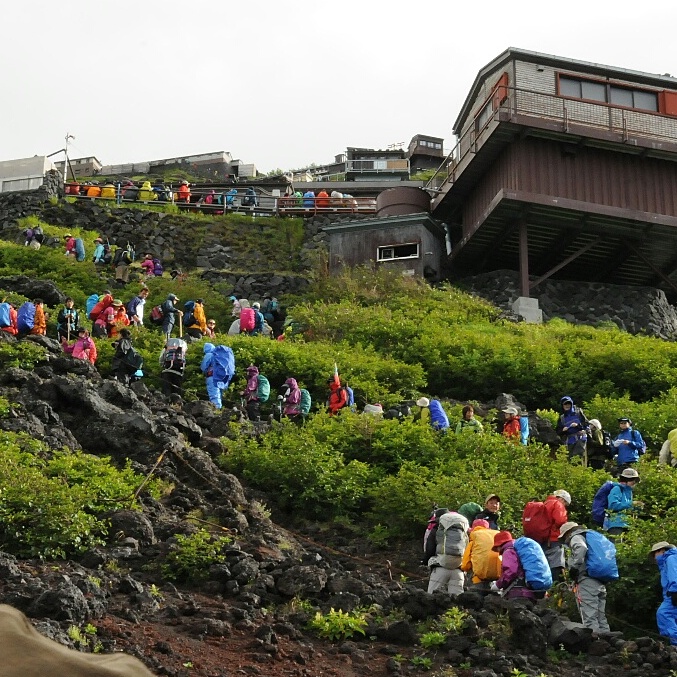
At the time, I couldn’t find a way of booking a mountain hut without going through an organised tour (due to not being able to speak Japanese), however I have just come across Fuji Mountain Guides who will make reservations on your behalf. So for ¥1,000 (less than £10) per person you can reserve a space in a mountain hut. The total cost for staying will be between ¥6,000 – ¥10,000 (about £45-£72) per person per night depending on meal plan. I had a little look into what the sleeping situation was in a mountain hut and I wasn’t keen! Imagine this, after 6+ hours of climbing up a mountain…
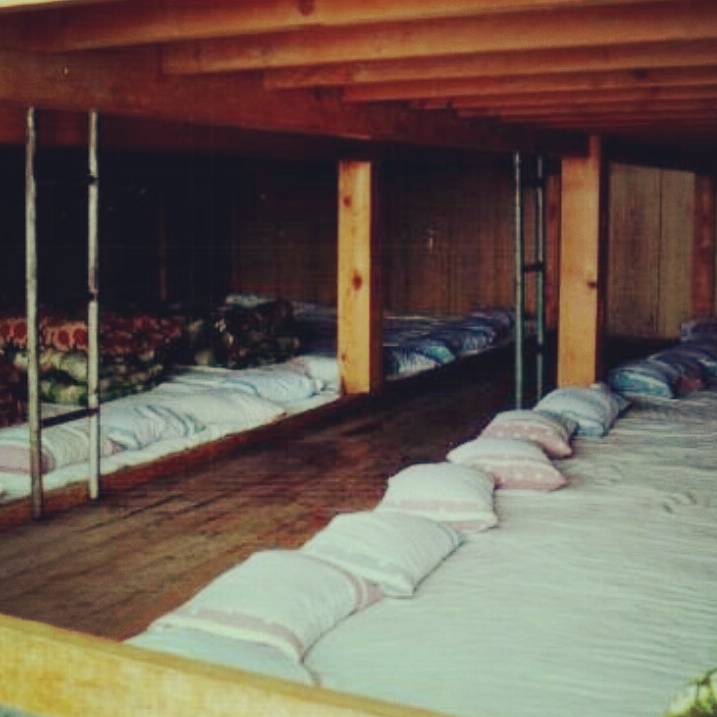
Hmm, I didn’t like the look of this set up and very much doubted that I would get any sleep at all meaning doing the second half of the climb after being awake for almost 24 hours! If you do fancy this (you’re mad – although I do admit I’m a little disappointed we missed out on the experience!) there is some handy ‘mountain hut etiquette’ available. So no mountain hut meant either no chance of seeing the sunrise or starting the climb in the early evening and climbing through the night.
The latter option both didn’t appeal and didn’t work with bus times to/from Tokyo. Plus, as the altitude of Mount Fuji is 3,776 meters, climbing too fast without a break is dangerous as it could lead to altitude sickness. We decided to give up on seeing the sunrise from the summit of Mount Fuji – though weren’t too bothered about this as seeing it was a gamble due to clouds and crowds.
Our last issue was how to get around the price of hiring hiking gear. My Tokyo Guide quoted ¥9,500 (about £70) each to hire jackets/pants set, shoes and hiking poles – the tour plus the gear would have worked out at almost the price we paid for our flights to Japan from the UK!
Fuji facts
I think it would be helpful to include some facts about climbing Mount Fuji before I explain how we got around the issues above. (This is a summary from japan-guide.com’s page on Climbing Mount Fuji.)
- The official climbing season is from early July to mid September. During this time, all the trails and mountain huts are open.
- Mount Fuji is ridiculously crowded! Apparently 10,000 people climb Fuji a day during the climbing season! Japanese school holidays run from around 20th July – end of August so we made sure to plan our climb before then.
- Although the climb isn’t described as difficult, the altitude is 3,776 meters so the air is thinner as you gain altitude. This causes the risk of getting altitude sickness, which is why it is recommended to climb slowly, stopping to give yourself time to acclimatise to the altitude, and stay hydrated. The mountain huts sell bottles of oxygen to help with this but the only way to stop the altitude sickness is to descend the mountain.
- Mount Fuji is divided into ten stations – the 1st is the foot of the mountain and the 10th is the summit. Roads go up to the various 5th stations of the routes, which is where most people start climbing from. It is advised to get the bus to the 5th station and then wait there for a while to acclimatise to the altitude. The 5th station of the Yoshida Trail is 2,300 meters.
How to climb Mount Fuji…after a decent sleep and without paying a fortune!
After a lot of searching through various websites, blogs and guidebooks, I discovered that we could stay in Kawaguchiko for our climb. Staying overnight there, we could get up early and get the bus from Kawaguchiko Station to the Fuji Subaru Line 5th Station and climb using the Yoshida Trail.
During the climbing season, the first bus arrives at the 5th station at 07:35 and the last bus leaves at 20:40 (bus times). The ascent on the Yoshida Trail takes 5-7 hours and the descent takes 3-5 hours. We’re both pretty fit so decided we would have enough time to reach the summit and back before the last bus left. This would allow us to get back to Kawaguchiko to stay in a hotel with a proper bed and hot shower, which sounded much more pleasant than a mountain hut! We decided to stay at the Sawa Hotel, which is about a 10 minute walk to the station, where the bus leaves for the Fuji Subaru Line 5th Station.
We thought about buying hiking gear when we got to Japan but had no idea where to look and didn’t want to spend our time shopping for this. So we avoided paying for hiking equipment hire by buying in the UK and bringing it with us. We went to Go Outdoors, which is full of bargains, and packed our gear in one suitcase. Climbing Mount Fuji has a list of equipment that you should take and we followed this apart from the torch/flash tight as we didn’t plan to be climbing at night.
Forwarding luggage is very common but we needed the hotel to hold it for two weeks so I contacted Sawa Hotel before we arrived in Japan to check that it was ok. I got a response to say “It is a matter of your luggage, but it is ok.” – sorted. We forwarded the suitcase from Tokyo Station to Sawa Hotel for about £15 (more info on my Yon (Kyoto) blog).
An evening in Kawaguchiko
I think that Kawaguchiko is quite popular with tourists due to the lakes and Fuji-Q Highland theme park but our only mission was to conquer Fuji so we arrived late afternoon. We travelled from Nagoya, where we’d been watching a sumo tournament, and the train took about four hours and was covered by our JR Passes. At one point on the train we looked out of the window and saw Mount Fuji. We were pretty blasé about this, thinking that we’d get to see a lot more of it. Little did we know that we wouldn’t see it at all – so make sure you snap a pic if you see Fuji as the mountain is described as notoriously shy!
We arrived at Kawaguchiko Station to the rain and went next door to the tourist information office to ask for directions to our hotel. Instead of giving us directions, they phoned Sawa Hotel for us and someone came to pick us up 10 minutes later. We arrived at the hotel and were happy to see our suitcase waiting for us – success! We check into our room which was a little run down but nice and clean with a huge bed and nice little balcony.
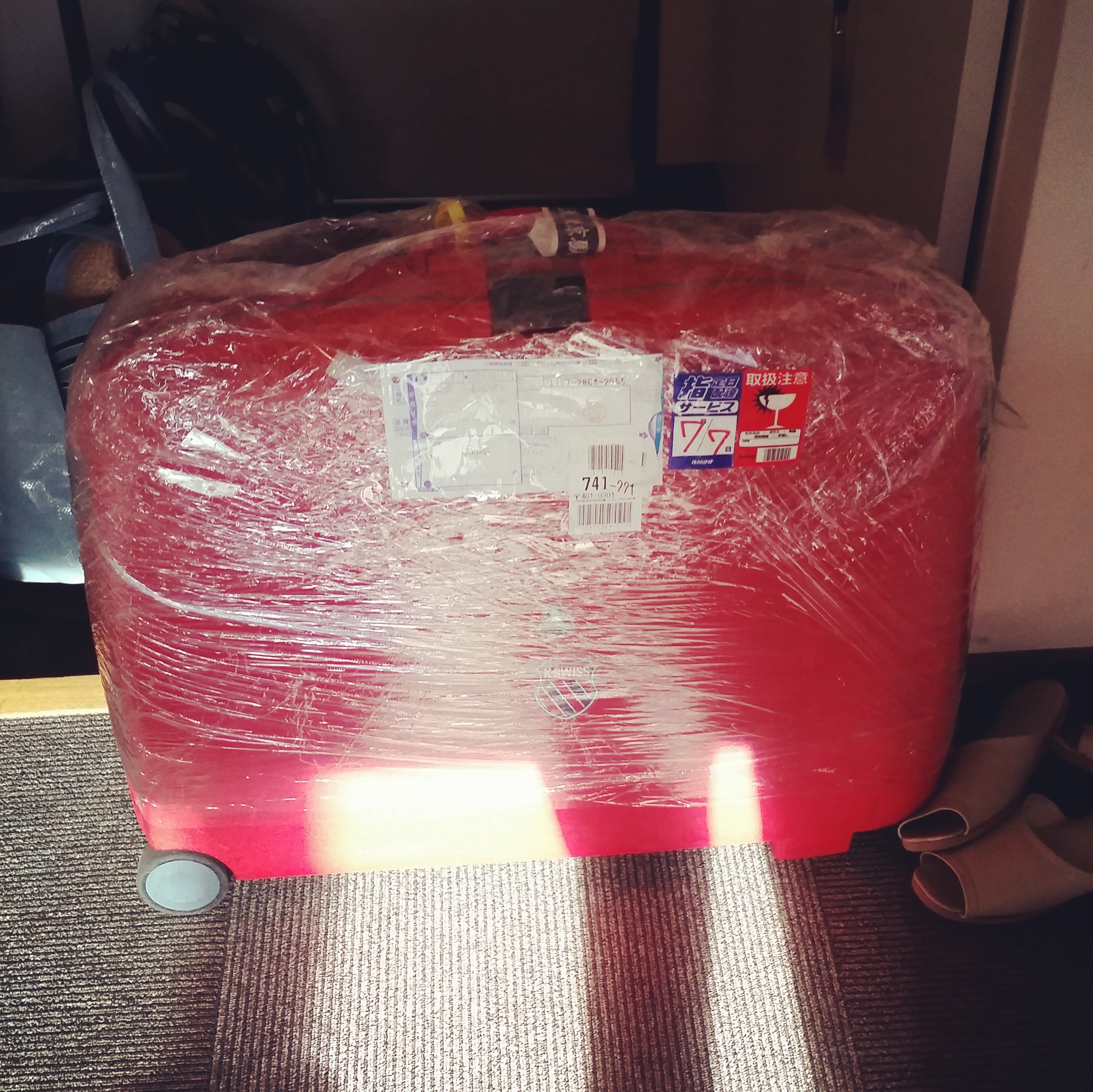
We went out in search of food and found somewhere near the train station called Fuji Tempura Idaten. As the name suggests, their speciality seemed to be tempura and we each ordered a set with udon noodle soup and tempura puffer fish. I thought that puffer fish was dangerous to eat but this was casually on the menu and we have lived to tell the tale so I guess this wasn’t the dangerous type!
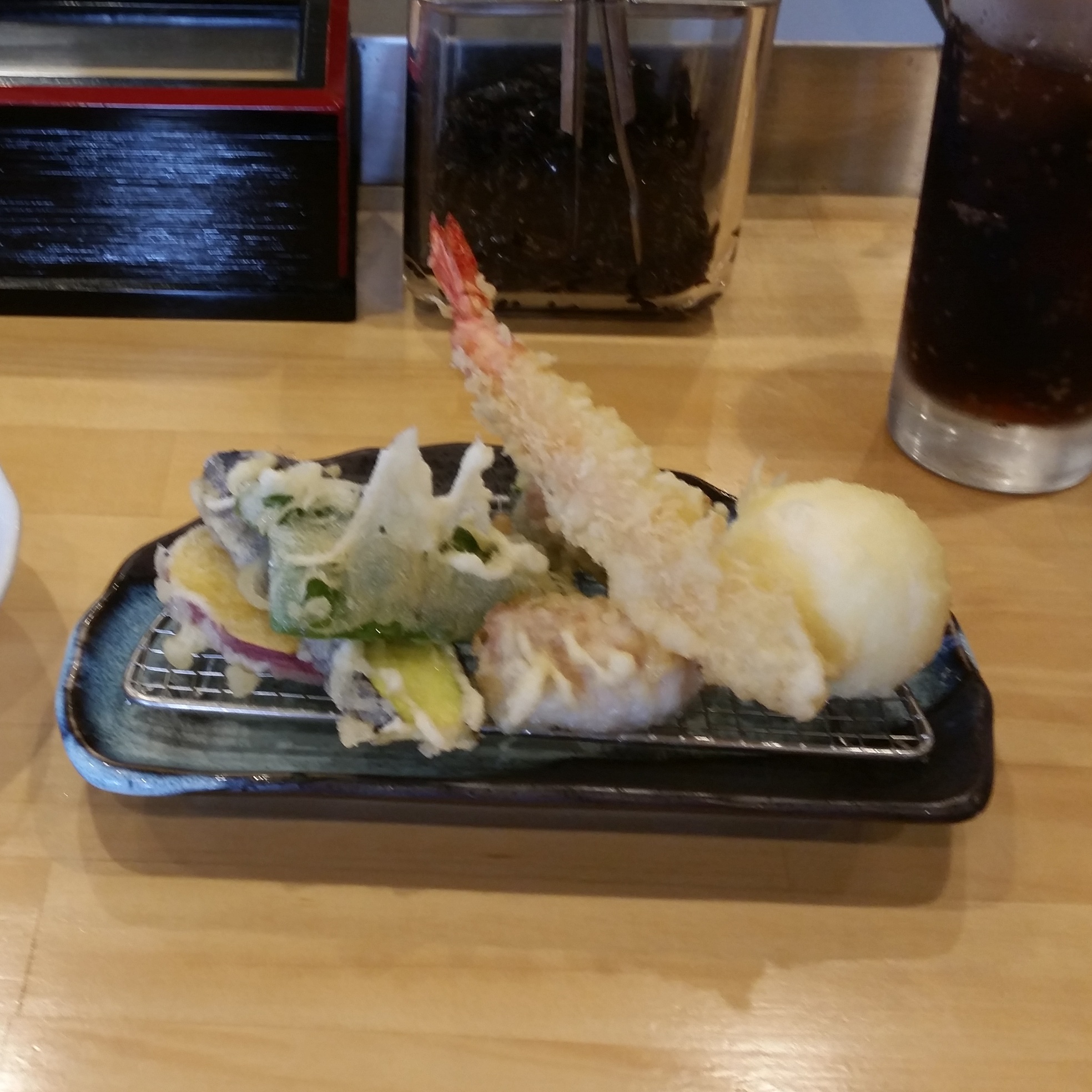
After dinner, we headed back to our hotel, via a 7-Eleven (which are all over Japan) to pick up some water and snacks for the next day’s climb. We also picked up some of the face masks that many Japanese people wear as we’d seen this advised to get through all the dust while climbing Fuji.
Attempting to climb Mount Fuji…in a typhoon!
A few days earlier, we had the TV on in our hotel room in Osaka and picked up something that sounded very much like the word ‘typhoon’ but we didn’t think much of it…
On the morning of our Fuji climb, we opened the curtains to be met with lots of rain. It had rained a lot during our trip to Japan so it didn’t really phase us, although I was really starting to resent the bottle of sunscreen we’d been carrying all around the country! We got ready, loading up our bags with food, water, trousers and jackets. I put a set of clothes in my bag within a plastic bag so they would definitely stay dry. I pondered with the idea of including underwear in this but decided against it.
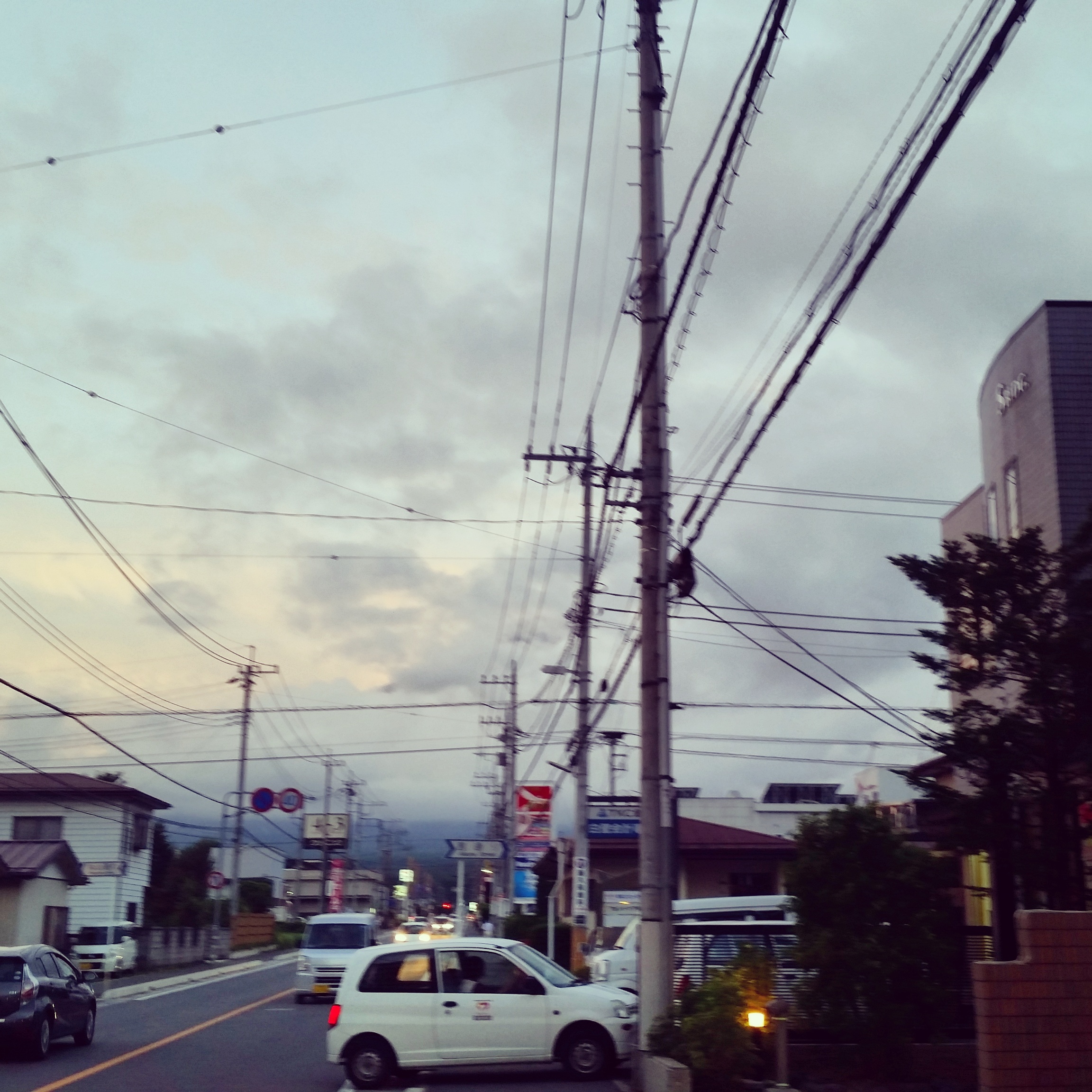
Under our umbrellas, we walked the 10 minutes to Kawaguchiko Station, where the buses leave for the 5th station. We caught the bus just after 8am and arrived at Fuji Subaru Line 5th Station just after 9am. Our plan was to spend about an hour at the 5th station to acclimatise to the altitude before setting off. We got a hot drink and had a wander around the shop which is full of Fuji souvenirs and has a few food outlets. There are also toilets downstairs which you have to pay a small fee to use. We had heard that you can buy wooden walking sticks that you take with you up to the summit and get branded with a hot iron at each station. This sounded like a very cool souvenir so we picked up a small one at the shop.
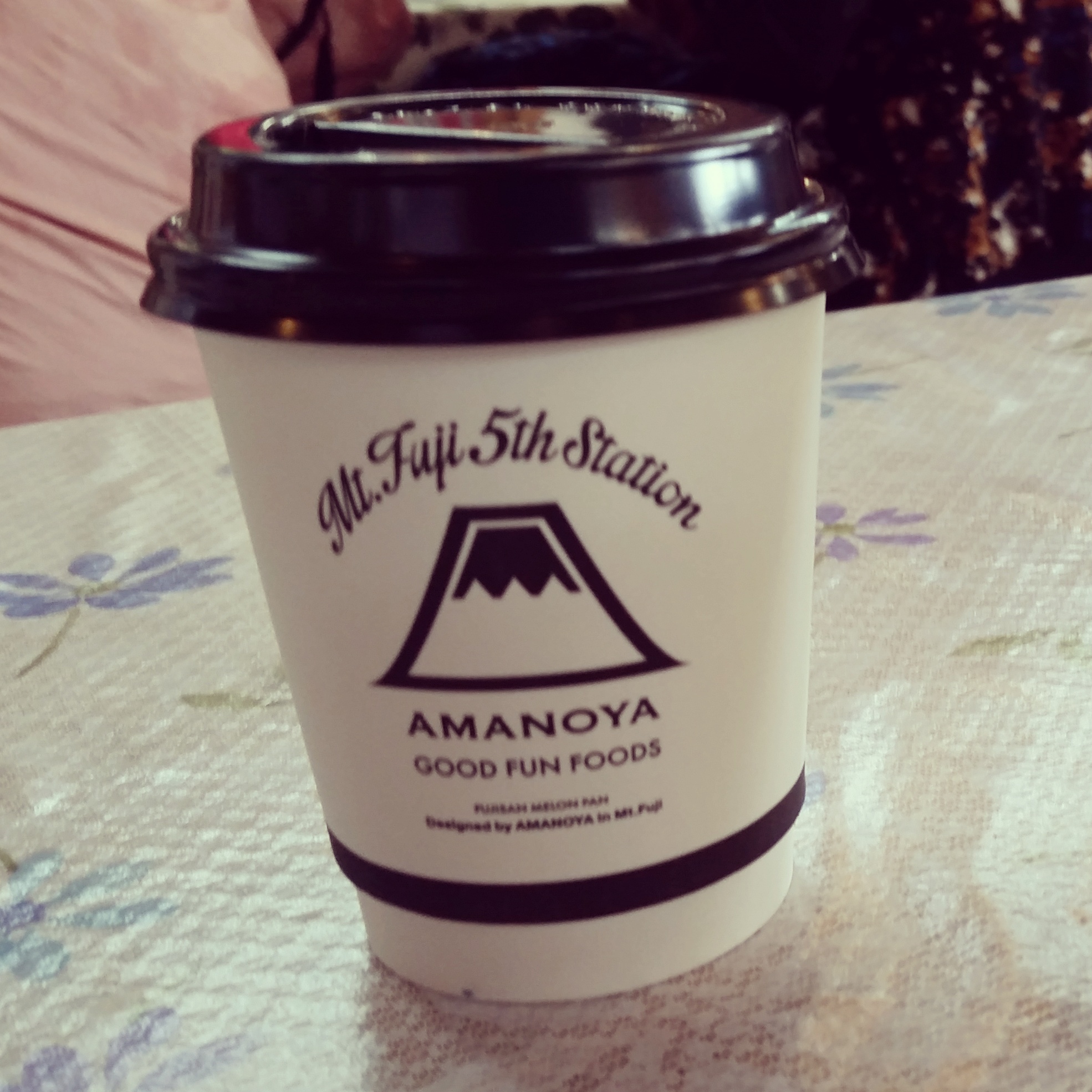
An hour after the bus had dropped us off, we put on our gear and headed in the direction of the Yoshida Trail. After a few minutes, we came across a big container which houses the collection station. Visitors to Fuji are asked to pay ¥1,000 each, which goes towards things like maintaining the area. I think this is voluntary but we were happy to pay it. The woman asked us if we were climbing Fuji today and we said we were. She didn’t speak much English but said something about not being able to climb today. However, she let us pay the fee and pass so we figured we would continue!
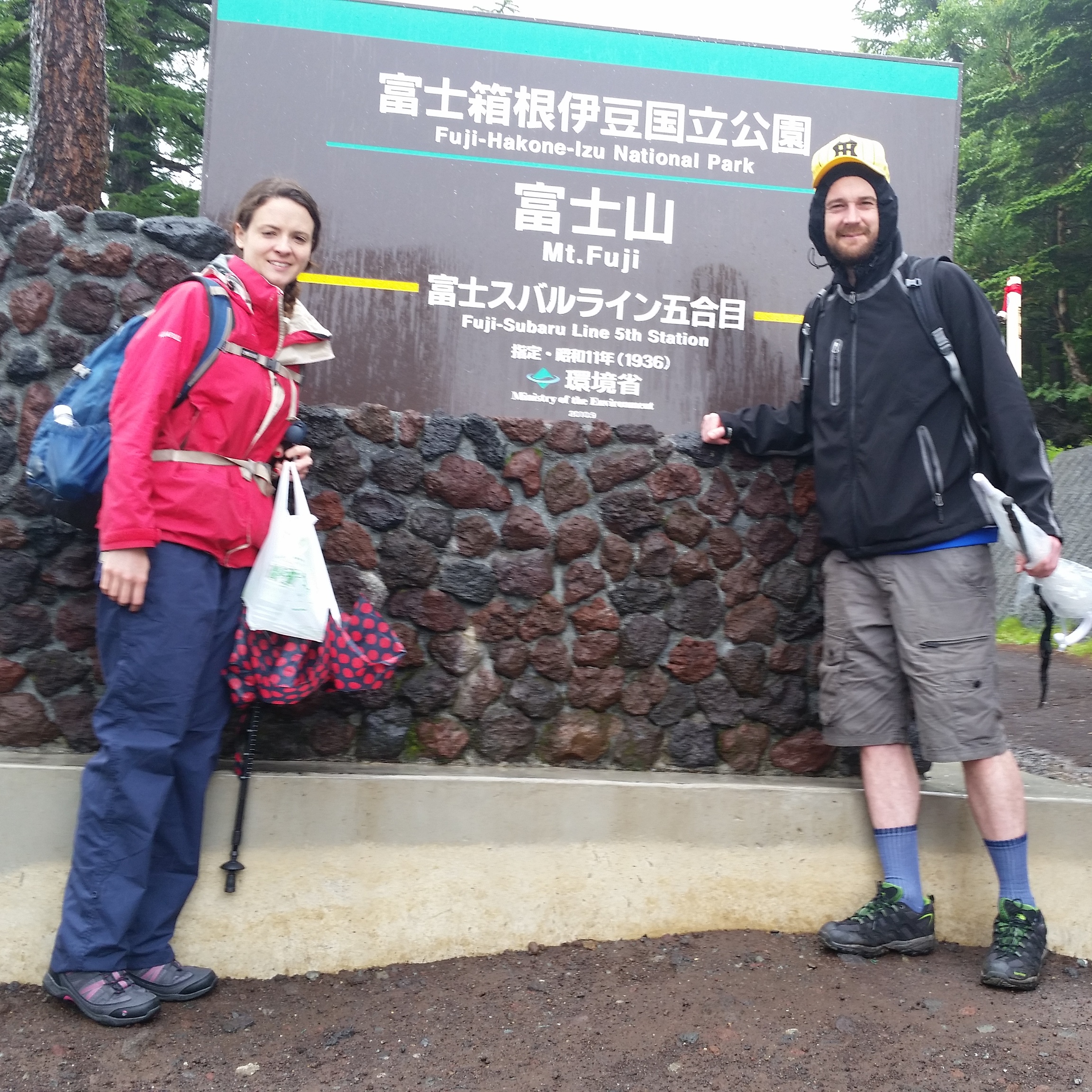
Rain still going strong, we headed up the mountain towards the 6th station, passing signs that told people not to ‘bullet climb’ (climbing quickly through the night) and advising not to climb in bad weather and to seek shelter in huts when heavy rain occurs.
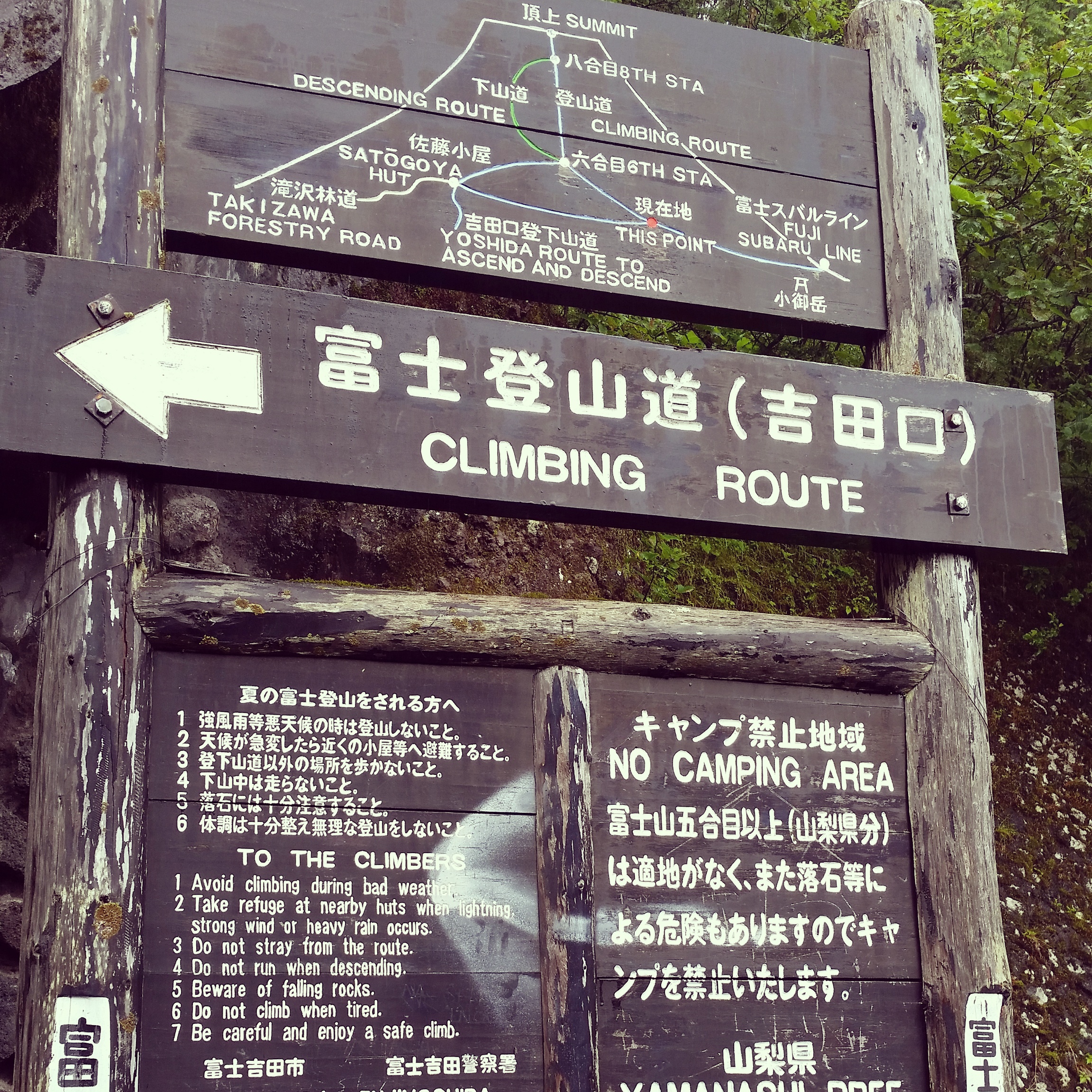
After a while we were stopped by a Japanese man with a folder. He worked out that we spoke English and pointed to a page in his folder, which (in various languages) said not to climb as there was a typhoon. David and I took a while to think about whether we would turn back and decided that we had come this far and, although it was very wet and unpleasant, the weather didn’t seem that bad. We decided to keep walking and see how the weather seemed. We motioned to the man that we were going to attempt the climb. He hurriedly flipped through the pages of his folder and pointed to another page, which said that we would be climbing at our own risk. Hmmm…we continued…
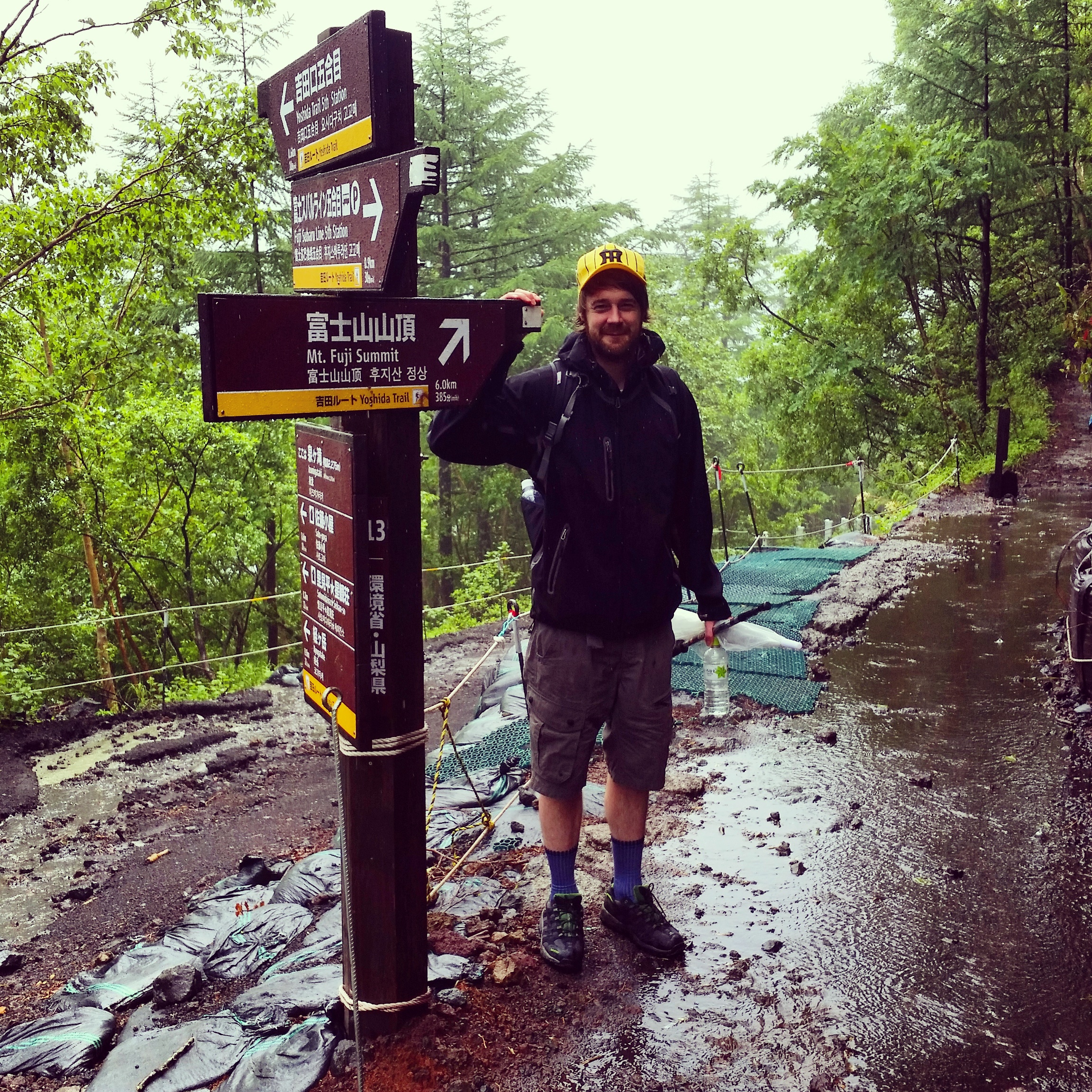
Although obviously uphill, the walk wasn’t too strenuous and we took our time to avoid feeling ill. To be honest, it’s not the prettiest of hills I have climbed and any view that we could have enjoyed was hidden by the thick clouds.
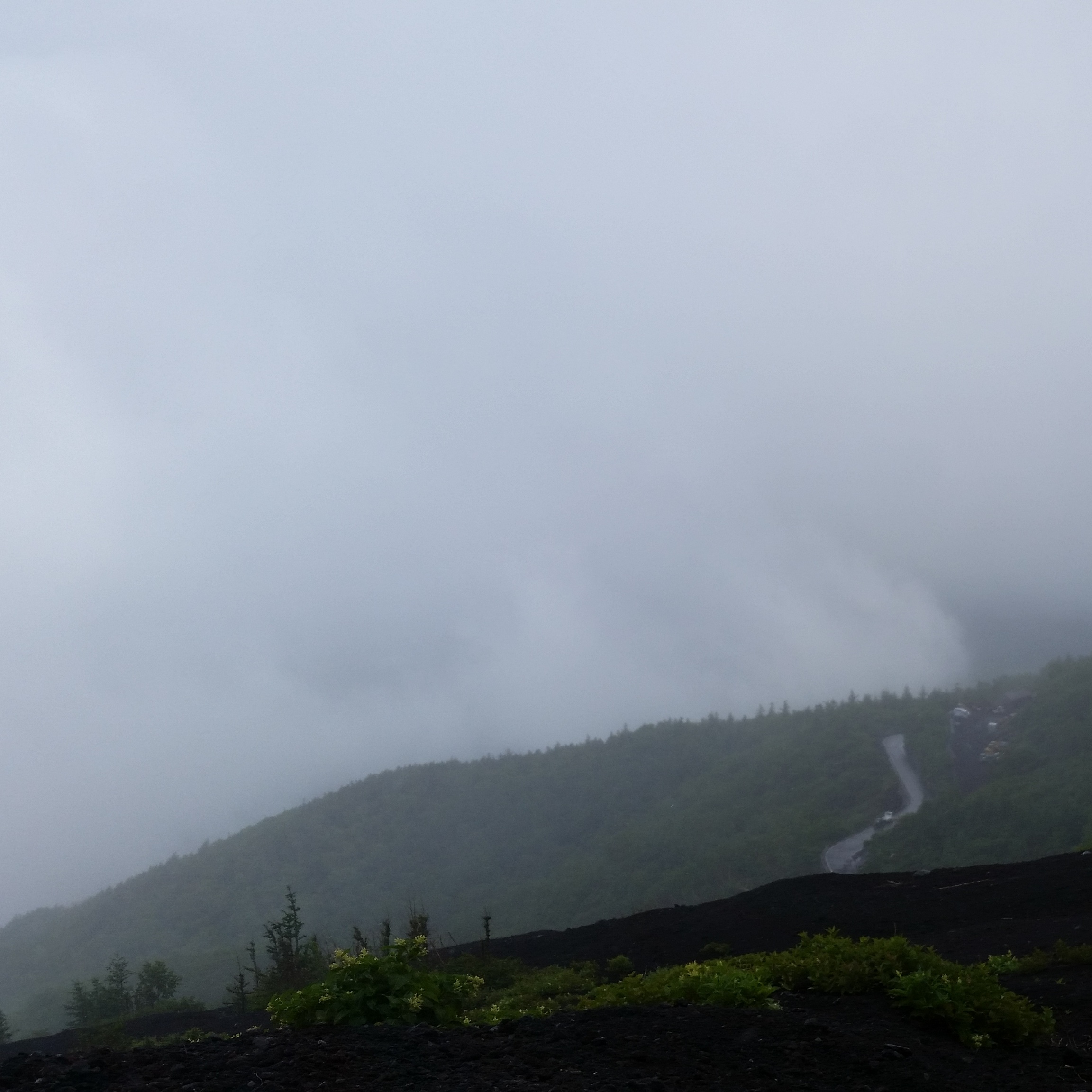
The rain got heavier as we climbed and by the time we got to the 6th station, we were absolutely soaked. I’m not sure if climbers are usually able to go inside the mountain huts at the stations as they ascend but we didn’t seem to have the option and the staff looked at us from inside their very warm and dry looking hut. We asked if they could brand our walking stick but were told that it couldn’t be done when it was wet – damn! We continued our climb…
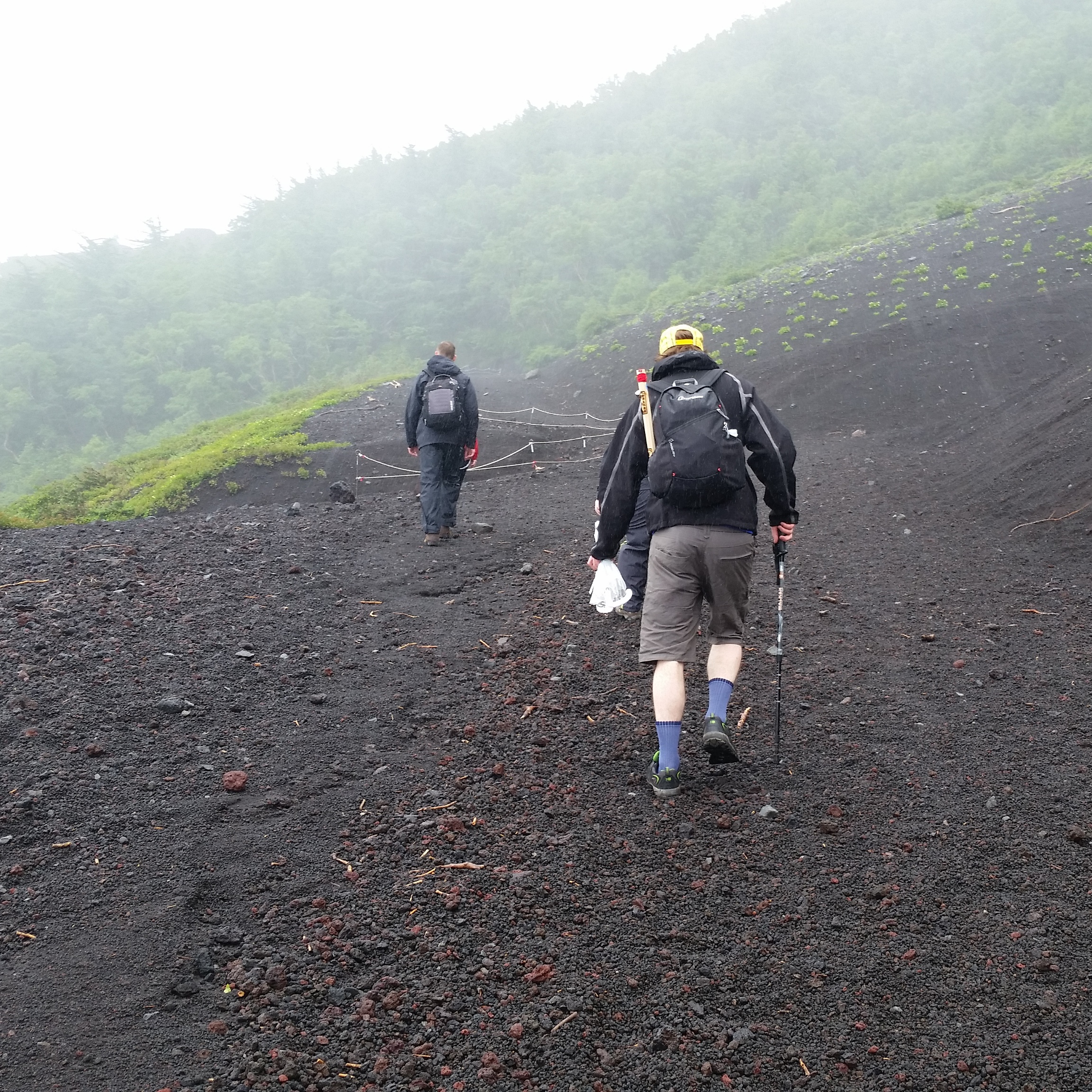
Along the route there are toilets that can be used for a small fee, which you put in a mailbox type tin, so it’s important to remember to take some change with you when you climb. There are also mountain huts at each station where you can buy water, drinks and food. These are quite expensive but I think that’s fair enough as they have the logistics of getting these up the mountain to sell.
As I mentioned earlier, we had read that there are usually 10,000 people climbing Mount Fuji a day during the climbing season. The only benefit of climbing in a typhoon is that it is much quieter and we saw about 10 climbers all day and only six went further than we did. We definitely didn’t experience a typical Mount Fuji climb!
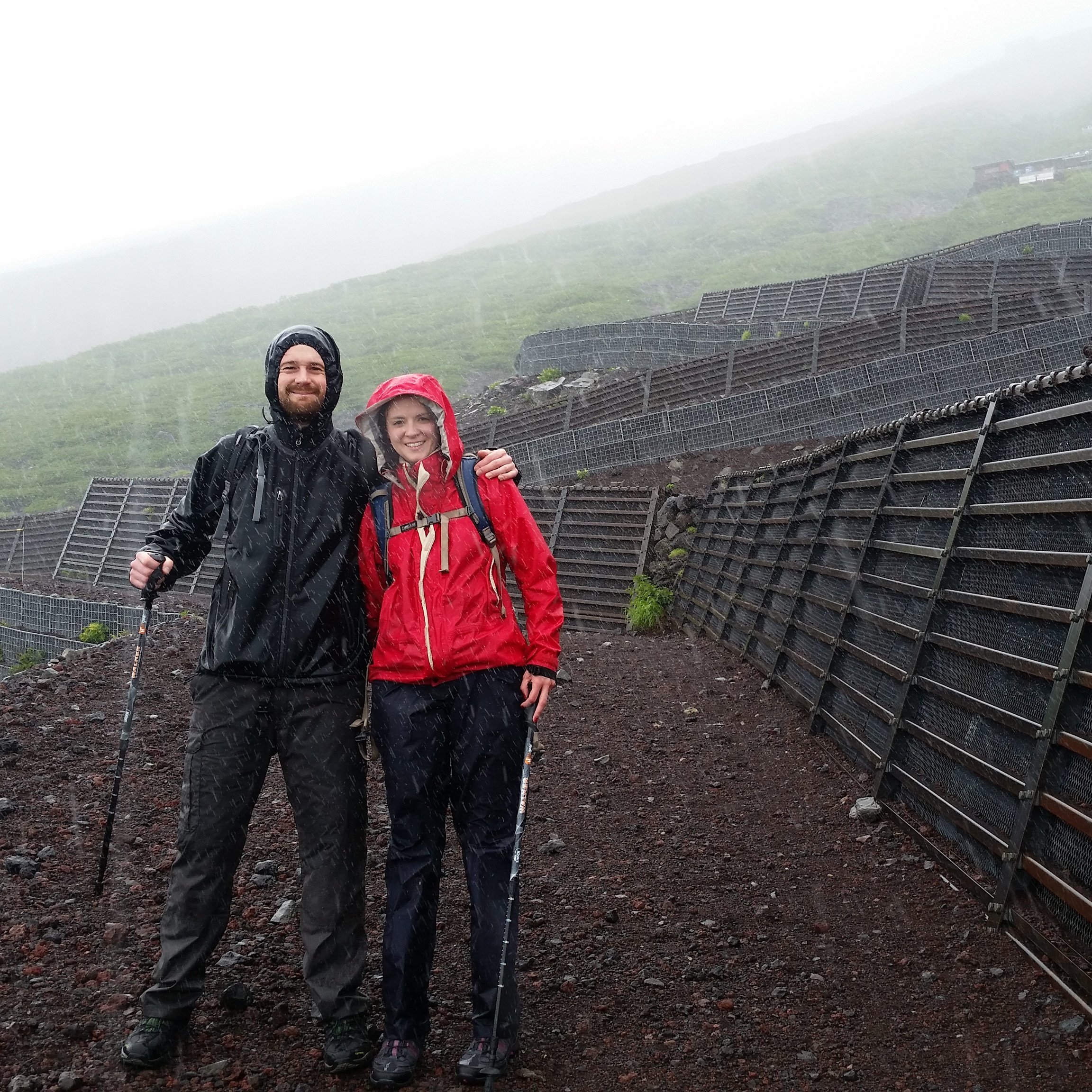
The terrain varies between paths, steps and rock that you have to use your hands to climb up. We climbed and got wetter and wetter. The rain was heavy but the wind didn’t seem too strong so we felt quite safe and felt happy to continue. A very enthusiastic Chinese woman walked alongside us, wearing a clear welding-type mask which could really have done with some window wipers! She took a picture for us and then powered on up the mountain. We also spoke to a group of three friends who had planned on staying in a mountain hut but lost them quite early on so think they turned back.
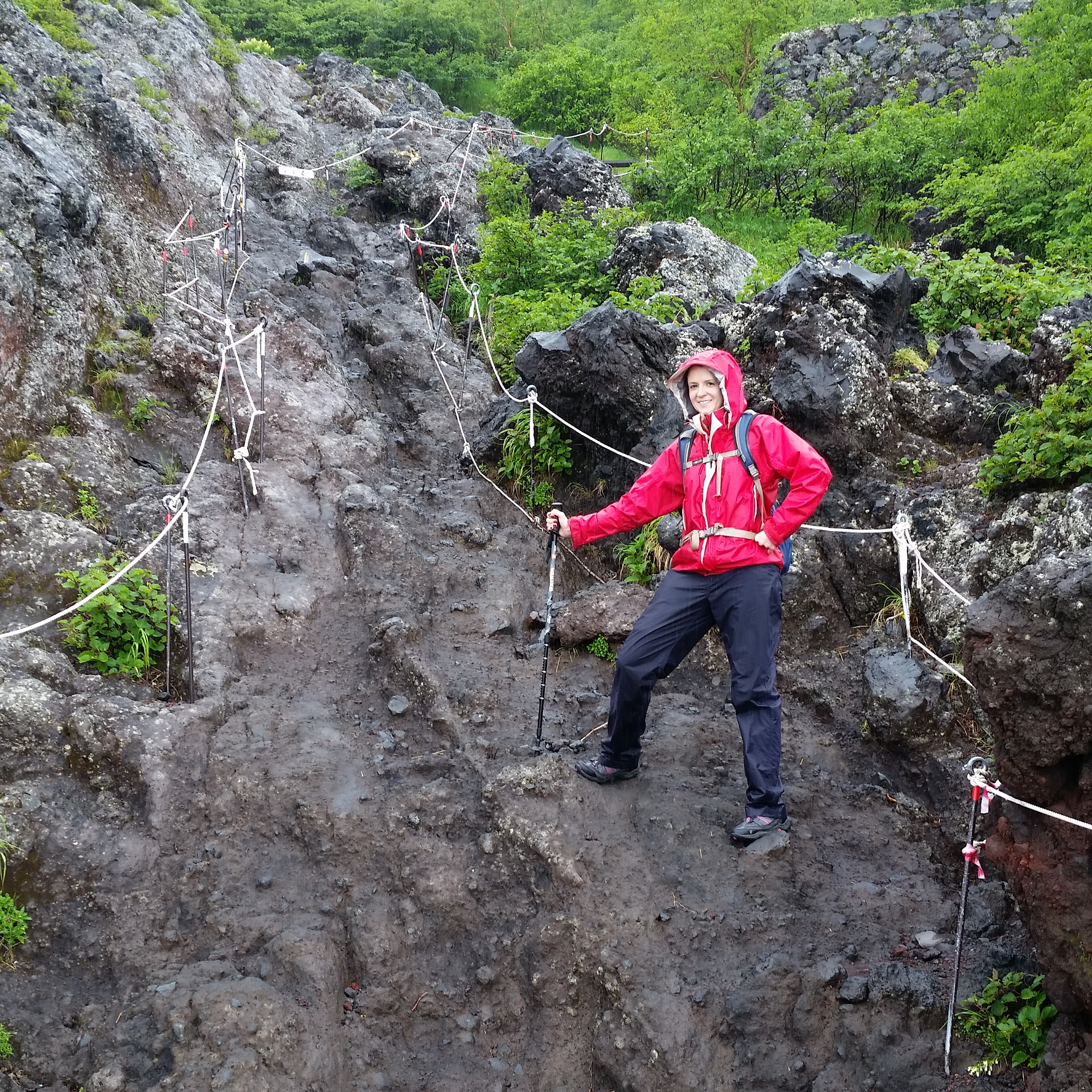
By the time we got to the 7th station (2,790m) at about 12.30pm (just over two hours after we set off), we were ridiculously wet, all our clothes were soaked through and our feet were wet. If there’s one thing I really hate, it’s having wet feet! Clearly our hiking gear was far from typhoon proof!
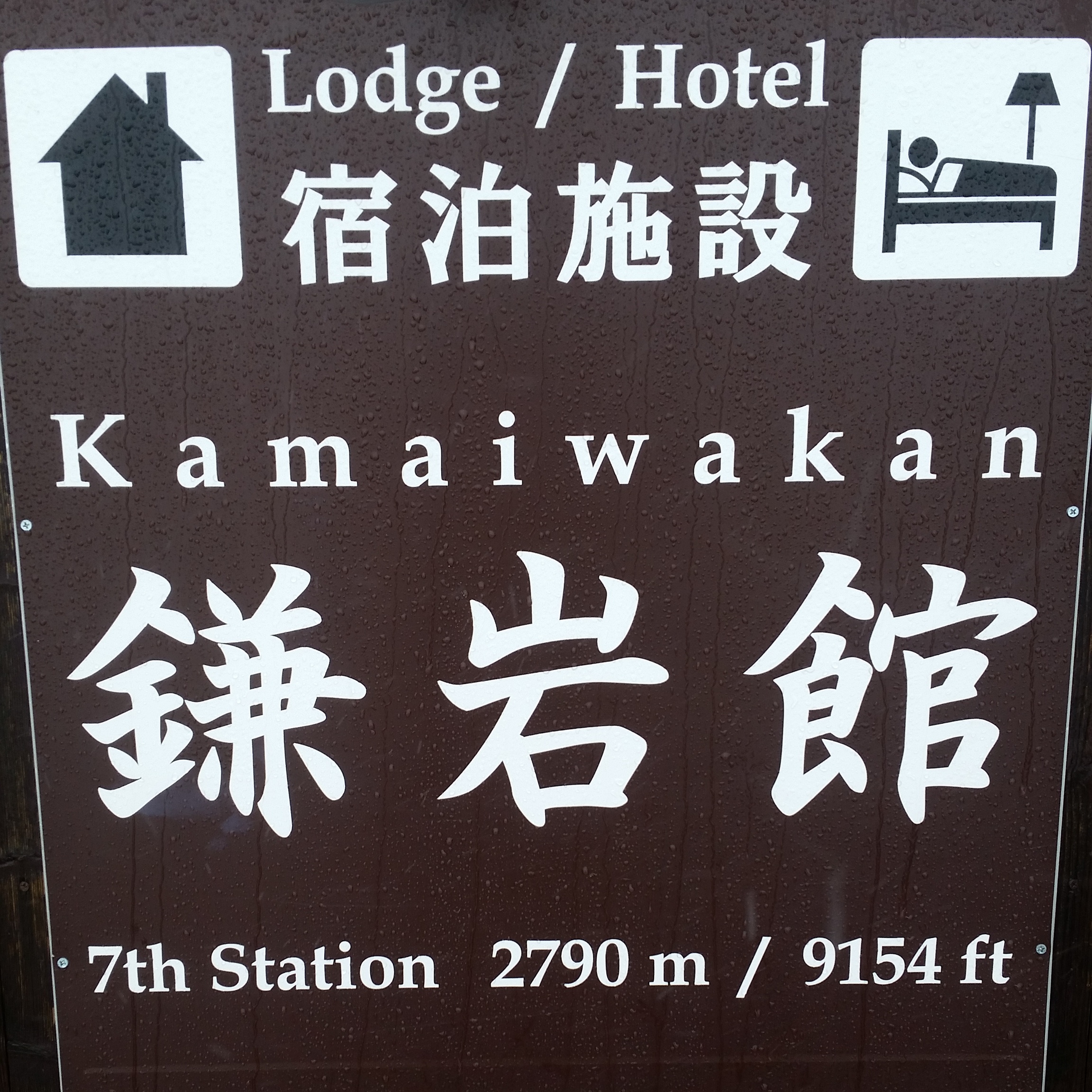
At this point, we decided there was only one thing for it…’turn back?!?’ I hear you cry. No – buy plastic bags from the mountain hut and put them inside our socks to keep our feet dry. A flawless plan! We bought the (expensive) plastic bags and went into the toilets to put them on under our socks. It was difficult to leave the warm and dry toilets but, flawless plan accomplished and walking stick still too wet to be branded, we headed back out into the rain to continue up the mountain.
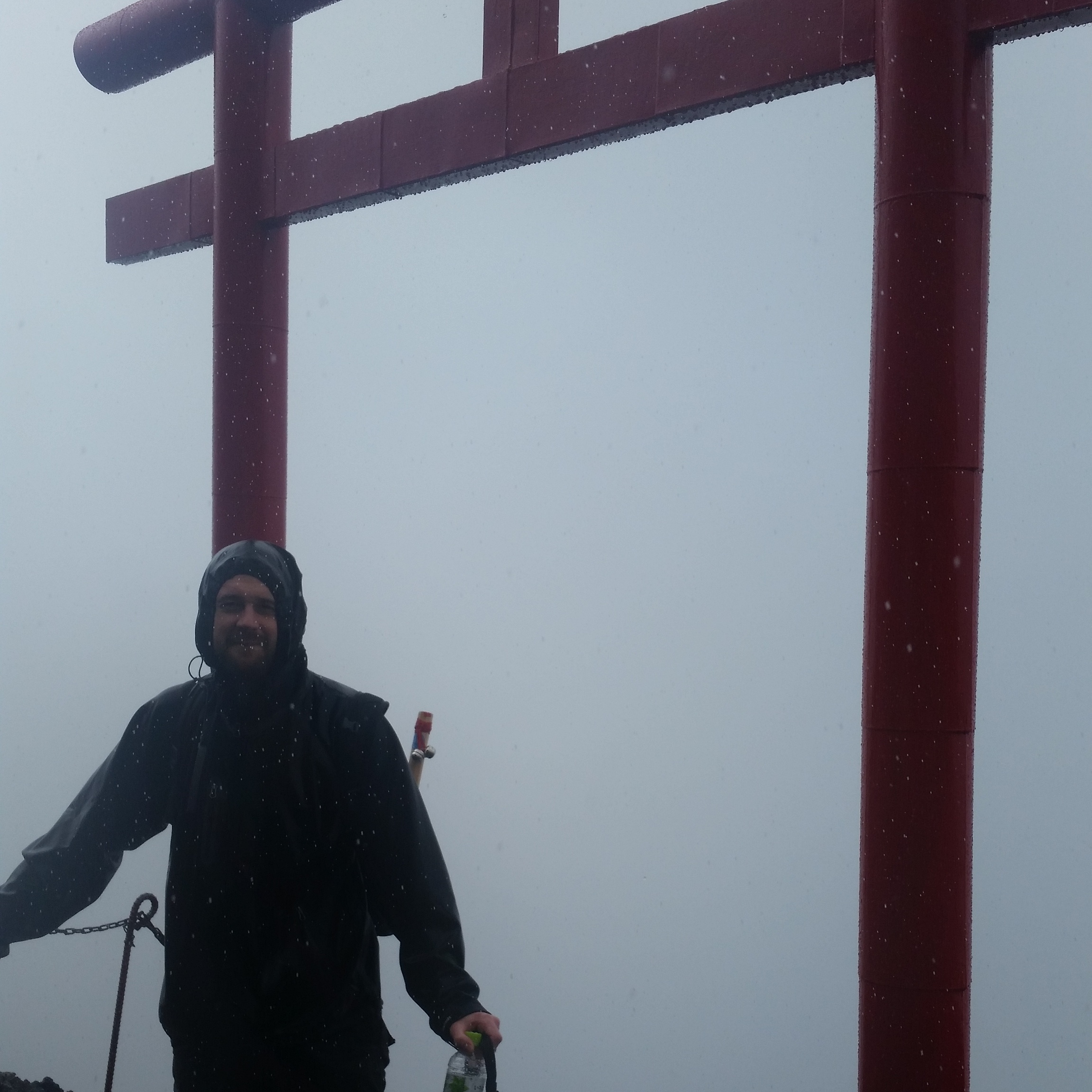
An hour of very soggy walking in the heavy rain later, we found ourselves at the 8th station (3,100m). There was a small block of toilets that we took shelter in to have a rest. The toilets had signs up to say not to do this as I image they get very busy when 10,000 people are climbing, but we thought it would be ok considering how few people were on the mountain. I took my boots off and literally poured water out of them. Clearly the plastic bags had been compromised during our walk and our flawless plan had failed! We spent some time in the toilet block weighing up our options. We could continue on or we could turn back. We both felt fine and well enough to go on but we were SO wet and knew the temperature would really drop the higher we got. We also knew that we had quite a walk back down to the 5th station. We decided that we’d given it a really good bash but to head back down the mountain. If our gear had better protected us from the weather and we weren’t soaked to the bone, we would have continued but walking in wet clothes was getting pretty miserable after about three and a half hours.
Another couple joined us in the toilet block and we had a chat to them about the climb and the crazy weather. We left them deciding if they were going to continue the climb and headed back into the rain. David suggested we head up just a little bit further to the next little hut before we found the path to start walking back down to the 5th station. We walked up to the next hut, where there was no one around, and David stopped to get something out of his bag and then got down on one very very soggy knee to propose! His plan had been to propose to me at the summit of Mount Fuji so he was disappointed that we couldn’t make it to the top. However, if it had been a normal day on Fuji, it would have been so busy and it was much more special to have the mountain to ourselves for a very lovely, soggy proposal! And the added drama of a typhoon made for a good story that we won’t forget in a hurry! Of course I said yes…
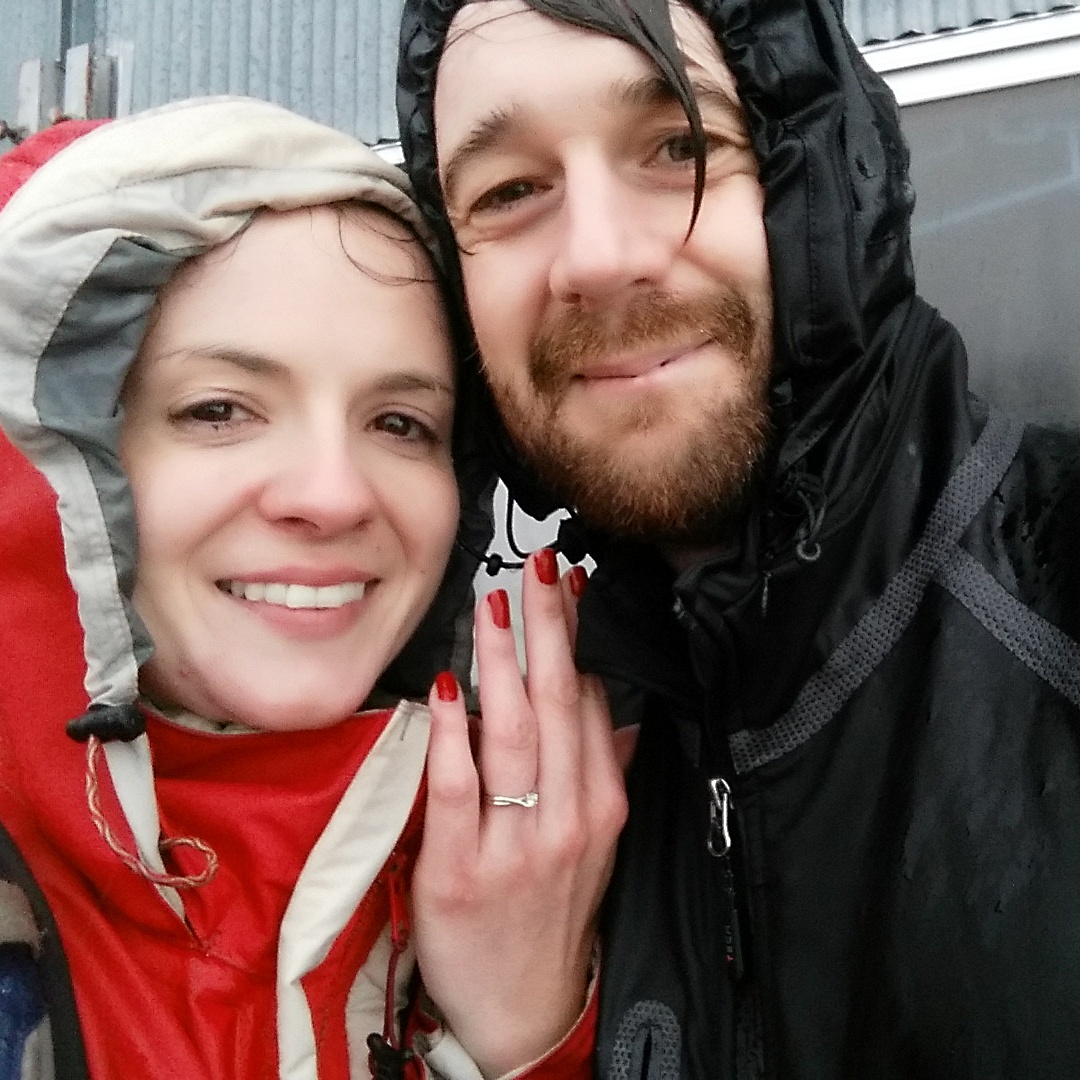
Newly engaged, we went in search of a way down the mountain. The Yoshida Trail has a different path up to the one down and there are only certain points on the trail that you can swap from the ascent path to the descent path. Luckily, the 8th station is one of those places and we started heading back down to the 5th station.
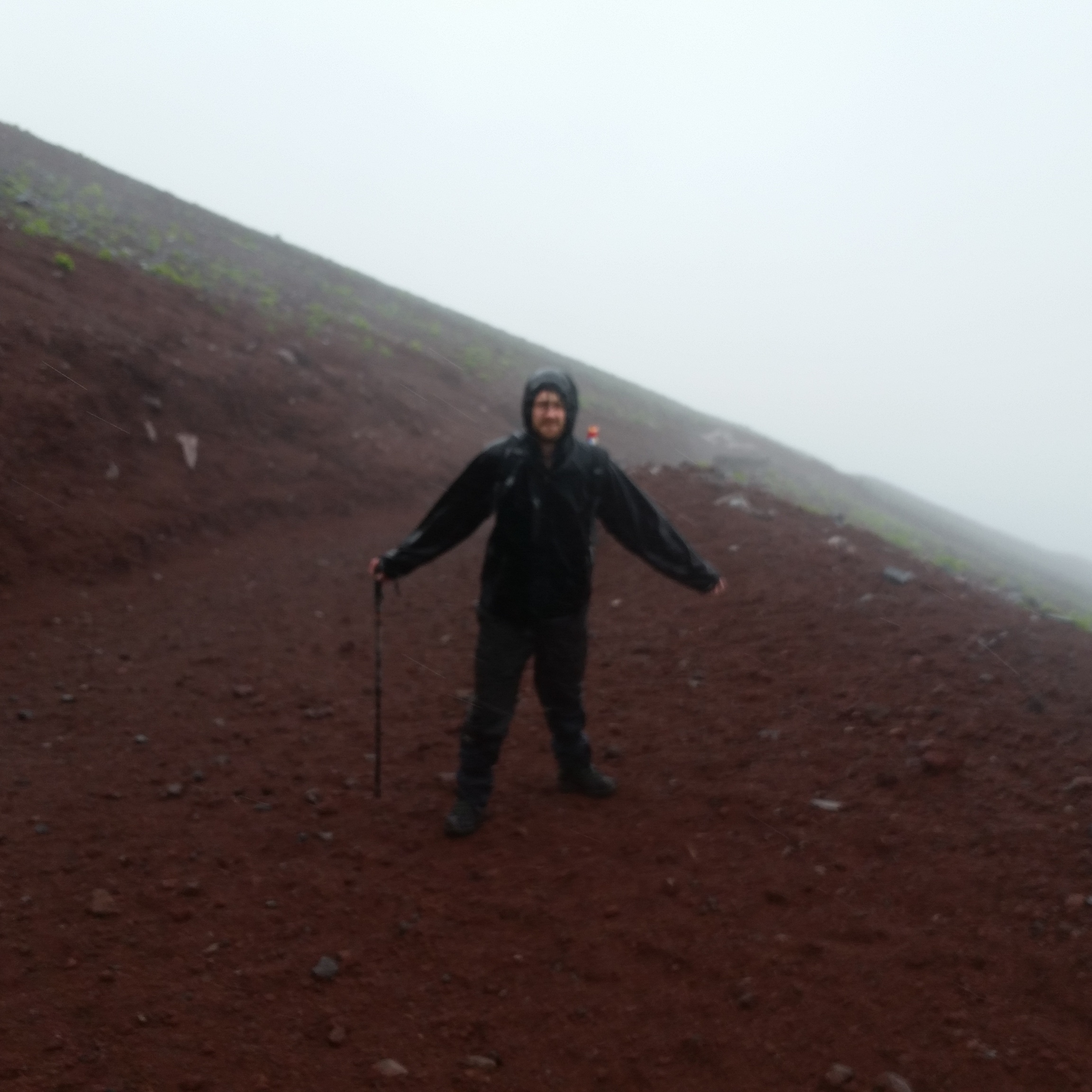
I’m not sure if the weather got worse or it was just that the descent route is more open, but the climb down seemed more windy and it took us about two and a half hours to get back to the 5th station. Just before the bottom of the route, we passed a group of Chinese people who asked how far up we had been. When we said the 8th station they were amazed and said we were awesome!
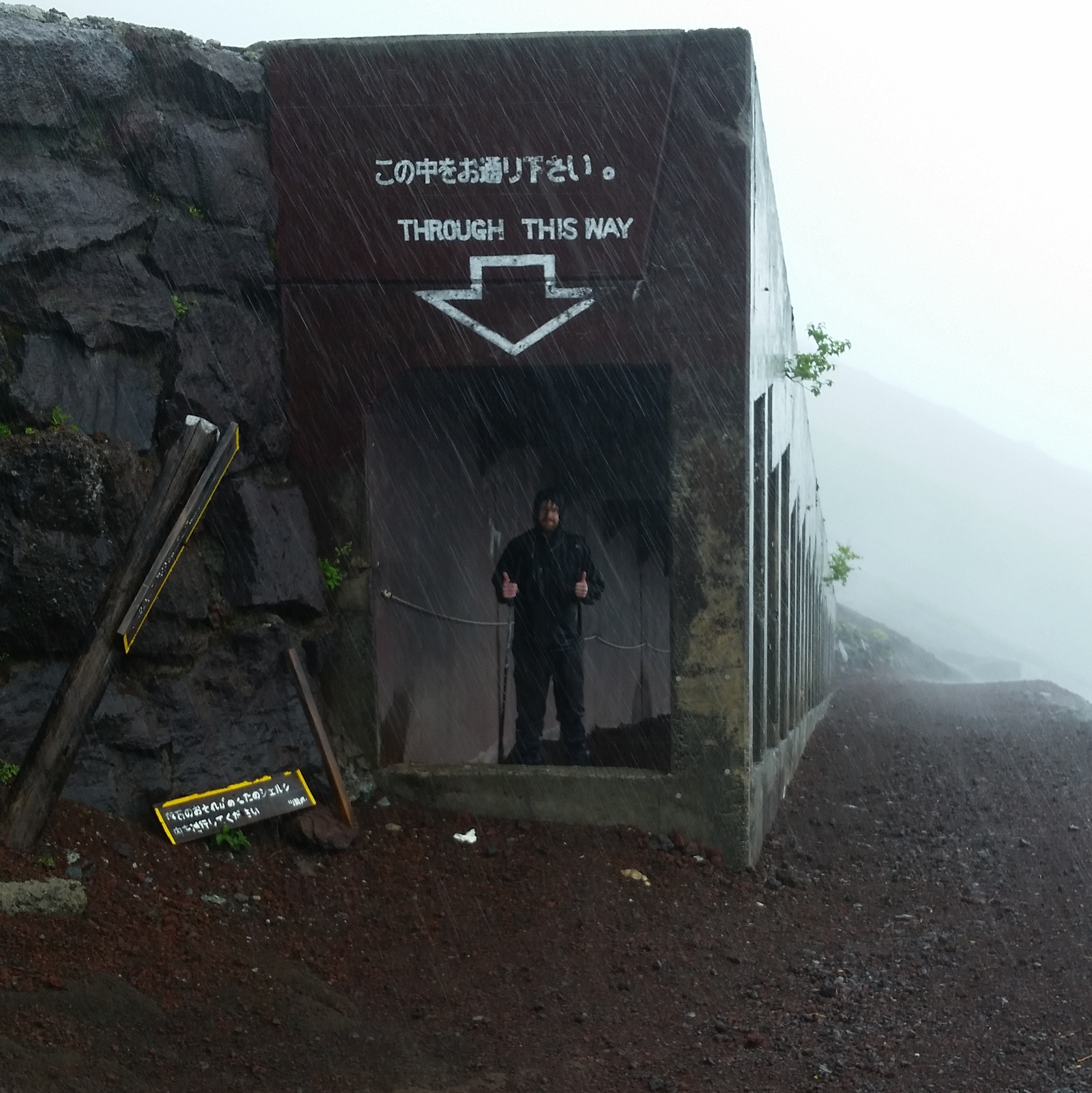
Possibly awesome, probably stupid, we were proud of our attempt! It would have taken us another three hours from the 8th station and it would have got a lot colder which would have been awful and potentially dangerous in soaking wet clothes. I definitely think that we made the right decision to turn back when we did and wonder if anyone actually made it to the summit that day.
We got back to the 5th station and changed into the dry clothes that were safely in the plastic bags in our backpacks. We got some food while we waited for the bus at about 5pm. Sitting on the bus with my soaking knickers, I really regretted not packing that extra underwear!
We got back to our hotel and had the loveliest hot shower (a mountain hut really wouldn’t have cut it!) and celebrated our engagement with some Cup Noodles that we had bought at the reception!
Fuji fools?
No blog about climbing Mount Fuji would be complete without the Japanese proverb:
“If you come to Japan and don’t climb Mt. Fuji, you’re a fool; but if you climb it more than once, you’re an even bigger fool.”
Would we climb Fuji again? Probably! If we were back during the climbing season, we’d definitely attempt to make it to the summit. Writing this, I do think we would have been sensible to listen to the warnings about the typhoon, however during our climb the weather never seemed anywhere near dangerous and we would have turned back if it did. I’m glad we decided against using a tour group – firstly because we saved a lot of money doing it on our own, but also because I’m certain the tour would have been cancelled and we wouldn’t be able to say that we climbed to the 8th station of Mount Fuji during a typhoon!
The next morning, we went to Kawaguchiko Station to catch the train back to Tokyo but the trains were all cancelled because of the weather so we had to get the bus instead. Also, the buses up to the 5th station were cancelled as the road was closed. So, although we climbed during a typhoon, I think we got lucky that we were able to attempt it and we got Mount Fuji almost to ourselves.
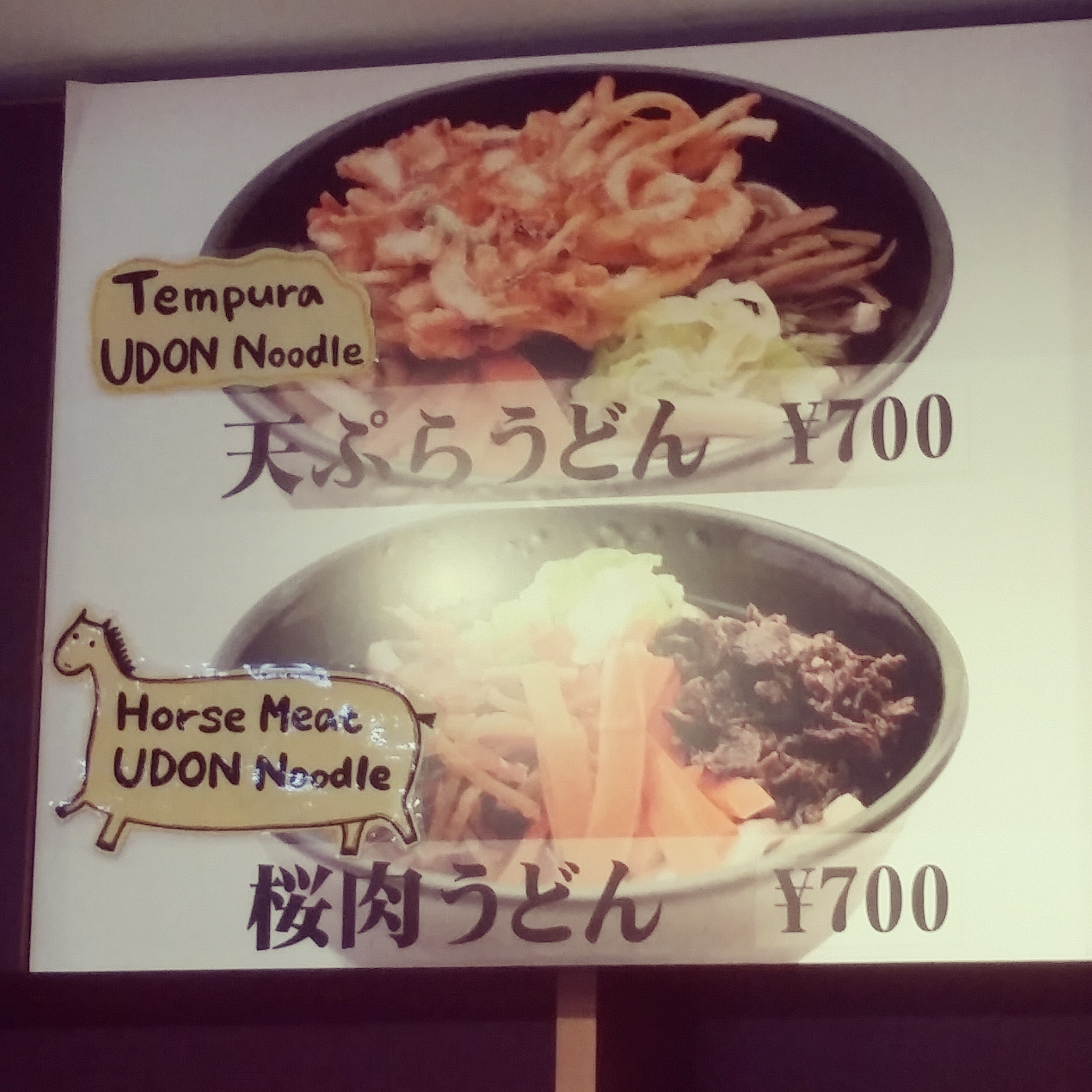
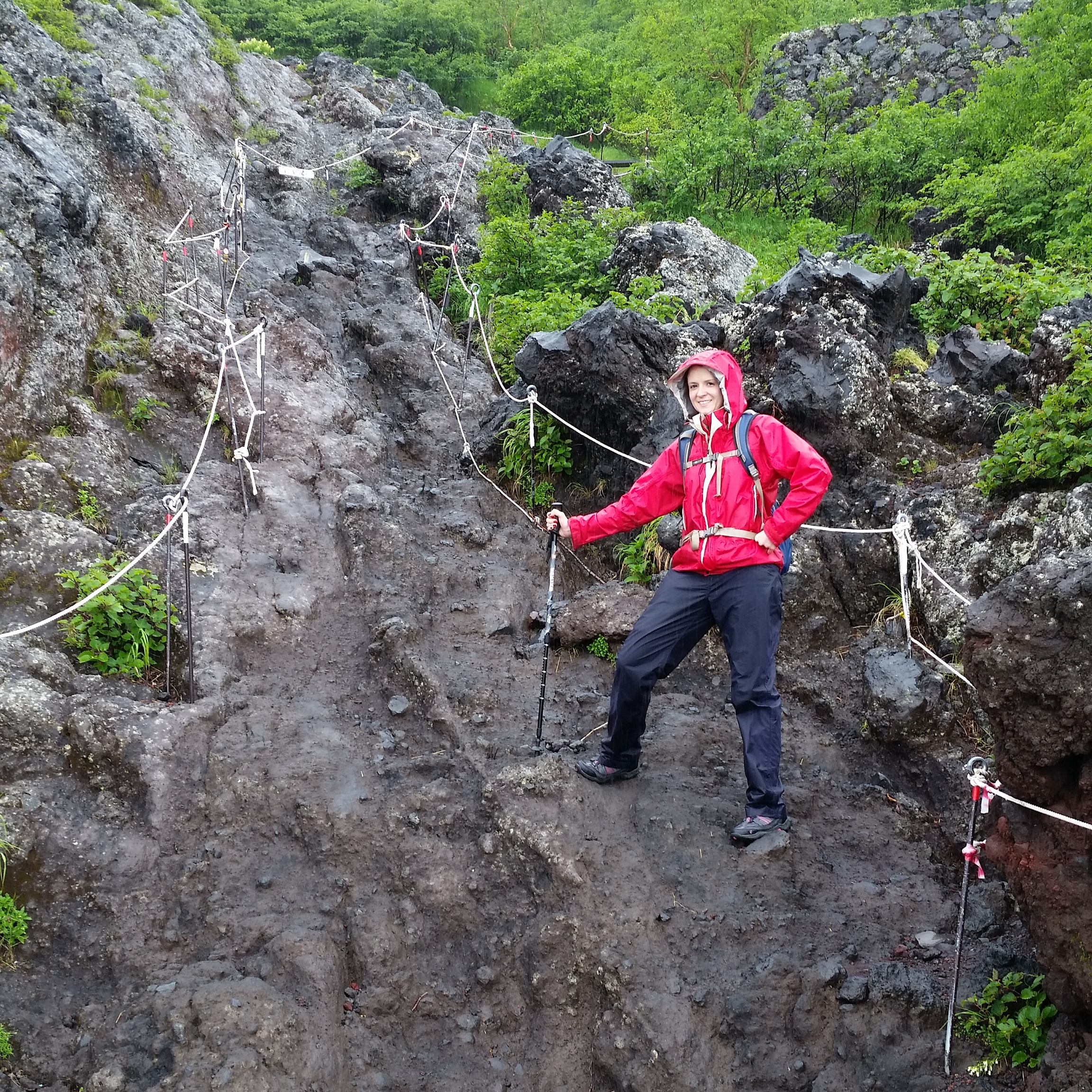
Extremely helpful points!
Are you going to climb Fuji?
Might consider it now 🙂
Try to avoid typhoons!!
Hi
First, thanks for this very helpful blog.
I have some questions about the bus from Kawaguchiko to the 5th Station :
– did you book it before ?
– if not, you have payed your seat when you got into ?
– if yes, where ? because I didn’t find information about it ?
Thanks a lot
Stephane (from an hotel in tokyo wondering if he could do the same trip in few days)
Hi Stephane. I don’t think we bought them in advance. Certainly no sooner than the evening before. The bus leaves from the train station and there’s a place to buy tickets there.
Thanks a lot, indeed tickets must be buy in the bus. We slept near Mt Fuji station the day before yesterday and took the first bus at 6:20 yesterday to the 5th station. There were about 40 people there. After the ascent and the return (under the sun) we took again a bus at 15h30 at the 5th station, then return to Tokyo by train. Thanks again. Stephane